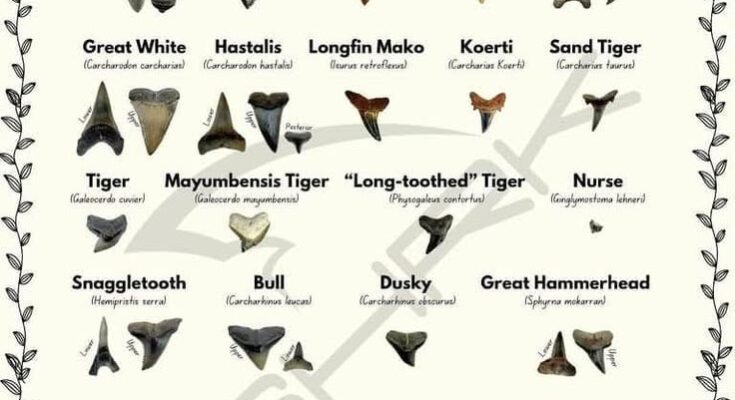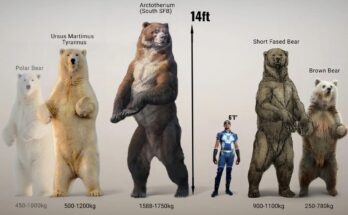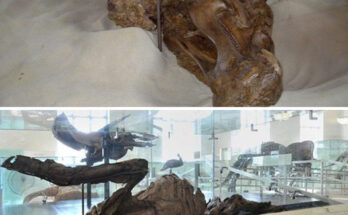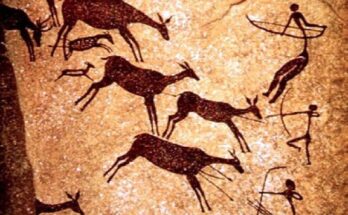Fossil Shark Tooth Identification: A Comprehensive Guide
Discover the fascinating world of fossil shark teeth with this detailed identification guide, featuring a diverse array of species whose ancient remains offer a window into prehistoric marine life. Sourced from the experts at SHRKco, this resource is perfect for enthusiasts, collectors, and those interested in crafting shark tooth jewelry, apparel, and more. Visit SHRKco.com to explore a wide range of products inspired by these ancient predators. Each tooth in this guide is accompanied by its scientific name and common characteristics, making it an invaluable tool for identifying finds from Michigan’s fossil-rich regions and beyond.

Megalodon (Otodus megalodon)
The Megalodon, an extinct giant, is renowned for its massive, triangular teeth, some exceeding six inches in length. These robust fossils, with serrated edges, hint at a predator that dominated ancient oceans millions of years ago. Often dark brown or black, Megalodon teeth are prized by collectors for their size and historical significance, reflecting a time when these sharks roamed the seas.
Chubutensis (Chubutensis)
With a broad, robust shape, the Chubutensis tooth features coarse serrations and a slightly curved crown. This species, related to the Megalodon, showcases a powerful bite adapted for crushing prey. Its fossilized remains, often found in shades of gray or brown, provide insight into the evolutionary lineage of large prehistoric sharks.
Angustidens (Otodus angustidens)
The Angustidens tooth is distinguished by its slender, elongated form and fine serrations along the edges. Lighter in color, often ranging from tan to white, this species predates the Megalodon and offers a glimpse into the gradual size increase of ancient sharks, making it a key specimen for paleontological study.
Auriculatus (Parotodus auriculatus)
Featuring a unique, ear-like shape with smooth edges, the Auriculatus tooth belongs to a mackerel shark ancestor. Typically lighter in hue, these fossils are less common and highlight the diversity of feeding strategies among ancient marine predators.
Benedini (Parotodus benedini)
Similar to Auriculatus but with a slightly broader crown, the Benedini tooth showcases a smooth, polished surface. These fossils, often found in creamy tones, are rare and prized for their aesthetic appeal in jewelry and educational displays.
Great White (Carcharodon carcharias)
The modern Great White’s fossilized teeth are triangular with sharp, serrated edges. Ranging from white to dark gray, these teeth reflect the continuity of this species, offering a comparison between ancient and contemporary shark populations.
Hastalis (Carcharodon hastalis)
A precursor to the Great White, the Hastalis tooth has a broad, triangular shape with fine serrations. Often fossilized in black or brown, these teeth provide evidence of the evolutionary transition within the Carcharodon genus.
Longfin Mako (Isurus retroflexus)
The Longfin Mako tooth is slender and slightly curved, with smooth edges and a pointed tip. Typically light-colored, these fossils indicate a fast-swimming predator, with similarities to today’s mako sharks.
Koerti (Carcharias koerti)
With a narrow, pointed shape and minimal serration, the Koerti tooth is often light brown or gray. This species offers a look at the ancestral sand tiger sharks, known for their distinctive dental structure.
Sand Tiger (Carcharias taurus)
The Sand Tiger tooth is long, narrow, and slightly curved, with fine serrations. Fossilized in various shades, these teeth are common and reflect the species’ long evolutionary history in coastal waters.
Tiger (Galeocerdo cuvier)
Tiger shark teeth are oblique with coarse serrations, resembling a tiger’s claw. Often dark and robust, these fossils highlight the opportunistic feeding habits of this modern species’ ancient relatives.
Mayumbensis Tiger (Negaprion mayumbensis)
Similar to the Tiger shark but with a more rounded crown, the Mayumbensis tooth features bold serrations. These fossils, often dark, suggest a varied diet and habitat range in prehistoric times.

“Long-toothed” Tiger (Physogaleus contortus)
This variant of the Tiger shark has elongated, curved teeth with pronounced serrations. Fossilized in brown or black, these teeth indicate specialized feeding adaptations among ancient tiger sharks.
Nurse (Ginglymostoma libricus)
The Nurse shark tooth is small, broad, and flattened with a smooth edge. Typically light-colored, these fossils reflect a bottom-dwelling lifestyle, contrasting with more aggressive shark species.
Snaggletooth (Hemipristis serra)
Known for its asymmetrical, jagged edges, the Snaggletooth tooth is a striking find, often dark brown. This species’ unique dental structure suggests a specialized hunting technique in ancient seas.
Bull (Carcharhinus leucas)
The Bull shark tooth is stout and triangular with serrated edges. Fossilized in gray or brown, these teeth indicate a versatile predator capable of thriving in both saltwater and freshwater environments.
Dusky (Carcharhinus obscurus)
The Dusky shark tooth is broad and triangular with fine serrations. Often light-colored, these fossils point to a widespread species with a stable presence in prehistoric oceans.
Great Hammerhead (Sphyrna mokarran)
The Great Hammerhead tooth is broad with a notched edge and slight serration. Typically gray or brown, these fossils reflect the distinctive head shape and hunting strategy of this modern species’ ancestors.
Hammerhead (Sphyrna zygaena)
Similar to the Great Hammerhead but smaller, the Hammerhead tooth has a broad base and smooth edges. Fossilized in various shades, these teeth highlight the diversity within the hammerhead family.
Bonnethead (Sphyrna tiburo)
The Bonnethead tooth is small, broad, and smooth-edged. Often light in color, these fossils correspond to the shovel-shaped head of this modern species, adapted for foraging in shallow waters.
Cow (Notorynchus primigenius)
The Cow shark tooth is multi-cusped and robust, with a prehistoric appearance. Typically dark, these fossils suggest a scavenger-like diet, distinct from more predatory sharks.
Angel (Squatina angelus)
The Angel shark tooth is flat and broad with a pointed tip. Often light-colored, these fossils indicate a bottom-dwelling ambush predator, offering a unique contrast to open-water sharks.
Giant Thresher (Alopias grandis)
The Giant Thresher tooth is long and curved with a smooth edge. Fossilized in brown or gray, these teeth reflect the long tail whip used by this species to stun prey.
Bigeye Thresher (Alopias superciliosus)
Similar to the Giant Thresher but slightly broader, the Bigeye Thresher tooth is light-colored with a smooth edge. These fossils highlight the large eyes and deep-water habits of this species.
Lemon (Negaprion brevirostris)
The Lemon shark tooth is slender with fine serrations. Often tan or gray, these fossils indicate a coastal predator with a long evolutionary history.
This guide, adorned with detailed illustrations and scientific insights, celebrates the rich legacy of fossil shark teeth. Whether you’re identifying a find, crafting jewelry, or exploring Michigan’s fossil beds, this resource connects you to the ancient marine world preserved in these remarkable relics.



